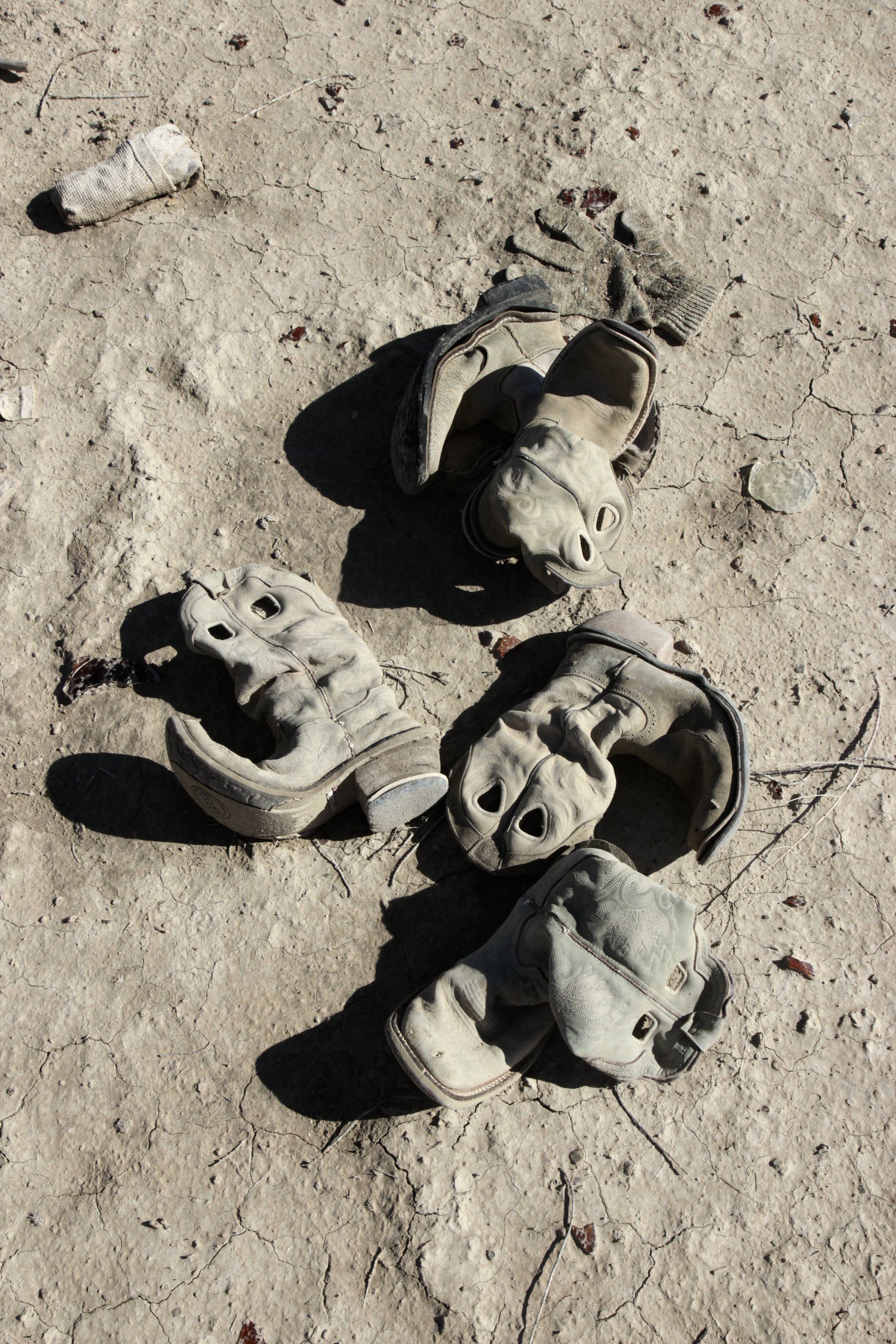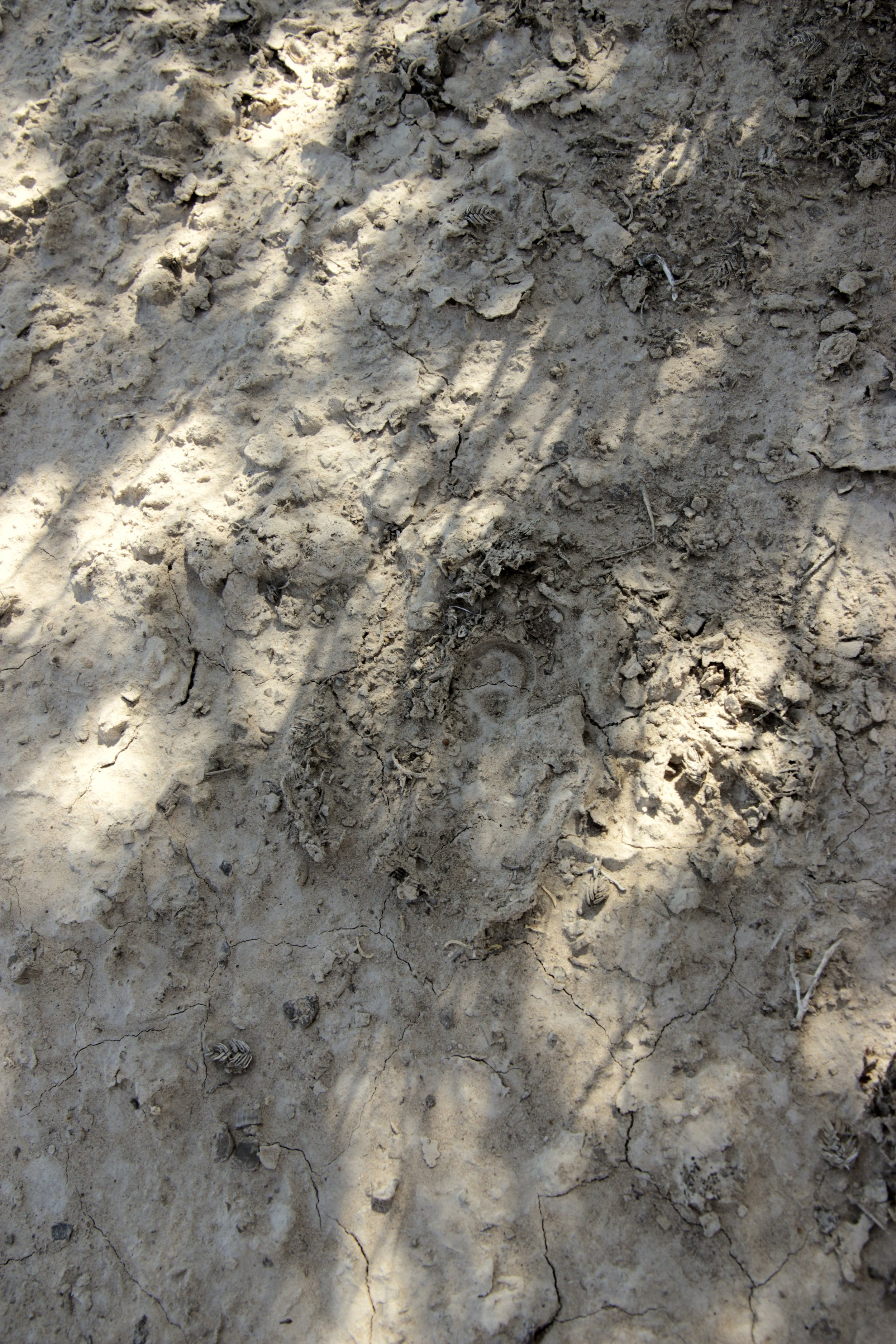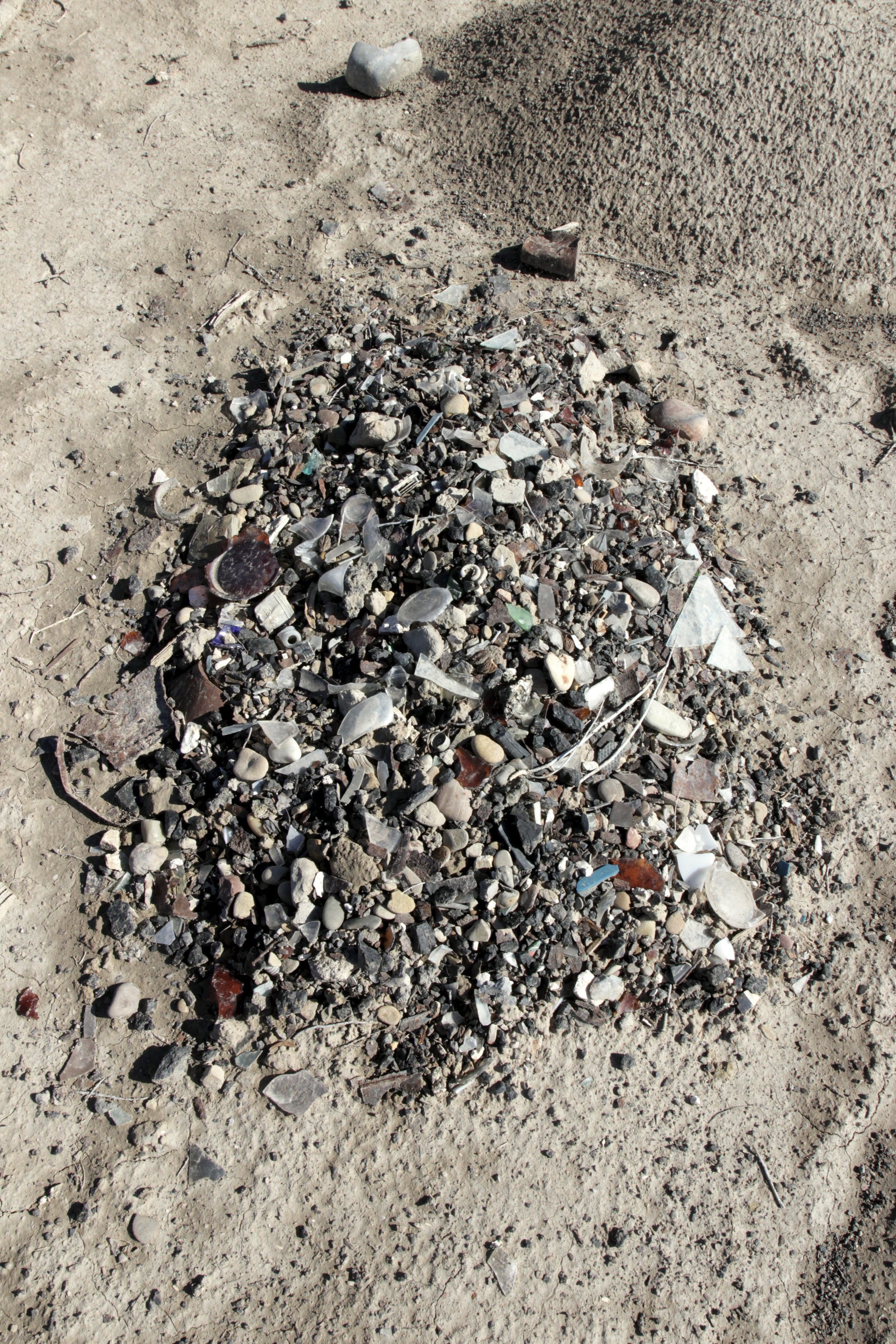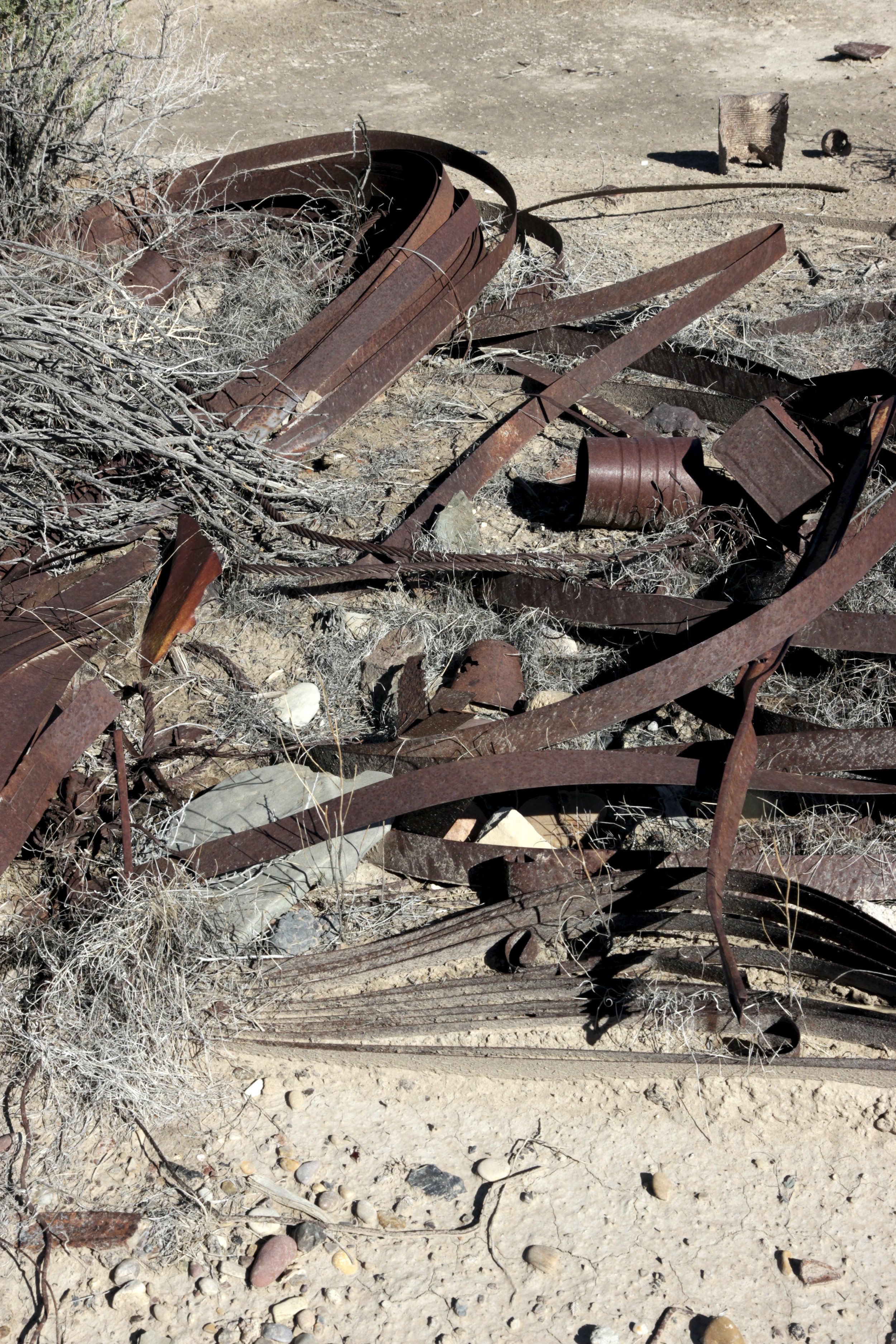Emily Arntsen

Frontier Fellow July 2022
Emily’s website
Emily Arntsen is a writer living in Moab, Utah, where the landscape is not merely the setting of her work, but often the main subject. She writes about life on the Colorado Plateau and the psychological tolls and spiritual rewards of enduring this hostile and imposing country. She grew up in Manchester-by-the-Sea, Massachusetts, and though she misses the ocean dearly, she feels at home in the ancient seabed that is now the Utah desert.
Memento Mori
We do not consider the debris
in the bowels
of the oyster
when we wear our mothers’ pearls.
An abandoned home balances above the ground on what remains of its foundation.
Typically, I would not collect trash. But today some primordial urge to forage overtook me. I walked out behind the high school into the scrubland that at one time must have functioned as an unofficial dumping ground, and I picked up shiny things, broken glass mostly, and some splinters of porcelain. I scrounged until my backpack overflowed with the remnants of a stranger’s bygone kitchen. In one hour, I accumulated enough fractured dishware to set the table for six.
A broken plate and a metal pipe scorch in the afternoon sun.
At home, I emptied my bag of spoils and at once began to bathe my trash. I arranged the clean objects in a pile and realized some pieces were older than others. This I surmised unscientifically. The clear glass was new, as was the porcelain with patterns that appeared printed with the lines of their designs unblurred. The cloudy glass was old. So too was the thick pottery with faded markings. I will not concern myself with whether these observations are correct because here, “new” and “old” are subjective terms. Dating these objects was an aesthetic exercise, and I knew “old” when I saw it. As long as the object seemed adequately weathered, it could achieve the desired effect, that is, evoke some vague sense of longing. Longing for what, exactly, was besides the point so long as I could indulge the sweet torture of wanting something I could not have. In any case, the “new” things were discarded for a second time.
I sat for a while and admired my collection, though I did not understand what made this trash more beautiful than other trash. I certainly did not know why I had spent the past four hours collecting and cleaning broken glass. But I knew that when my boyfriend came home for lunch, he would ask me what I had done that morning, and I needed a good answer to justify my time.
A pile of trash collected from behind the high school.
I’ve always been easily gripped by nostalgia. I know this teeters on the edge of what people call “bad taste,” though I’ve never gone so far as to determine why. For weeks, I returned to the dumping ground and contemplated this.
I sat on a cinder block and studied the shallow ditch of rusty cans. I did not care for these. I wondered about the springs that used to be a mattress. I did not care for this either. I paced around a pile of cowboy boots. Two and a half pairs, five boots, laid in the sand with toes curled back in thirsty rigor mortis. Where was the sixth? I liked the boots. I prodded at a cow spine. A little too fresh to take home, but I did it anyway. I was greatly unnerved when I came across a doll’s head. I almost walked straight back to my car, but curiosity got the best of me. I unearthed the smooth, plastic flesh, and though I did not like the head, I put it in my backpack anyway and thought for a while about the impression of her tiny ear in the sand.
Left: Two and a half pairs of cowboy boots.
Middle: Flood waters swept a collection of crushed cans into a shallow ditch.
Right: The impression of a doll’s ear in the sand.
I left the Bud Light cans and the plastic comb behind. I suppose I did this because I already know about Bud Light cans and plastic combs, and thus they are not clues about far-away worlds made distant by either time or space. I suppose I left the Bud Light cans because they were not sufficiently time-worn, and unlike the other fragments I collected of similar beverage-bearing vessels — thick bottle necks and glass basins inscribed with their local cities of origin — I knew the Bud Light cans would never last long enough to develop the patina of whatever “sufficiently time-worn” meant. I couldn’t muster a feeling of nostalgia for something I knew would corrode to dust before any future wanderer in this dumping ground would even have the chance to imagine a time before her time when Bud Light cans in the scrubland behind the Green River high school might have meant something specific.
My distaste for Bud Light cans is not a grievance with modern manufacturing, though. I do not, in other words, long for a time when beer only came in bottles simply because I find the enduring materials of yore more elegant. More importantly, I long for specificity, and in my delusional and cinematic understanding of eras and zeitgeists, things like beer brands are powerful synecdoches. In this sense, I dislike Bud Light as a concept because it is non-specific, by which I mean mid-tier and generally inoffensive. It strikes the most mediocre balance between affordability and flavor, and for this reason, is consumed by people across the nation for no reason other than its convenience. The shared experience, for example, of the alfalfa farmer in Green River and my father in Massachusetts ends at Bud Light consumption. How fortunate that the promises of modernity and mass production yielded an endless bounty of beer. Too bad that beer is a watered-down Budweiser in a single-use can.
More than anything, my distaste for Bud Light represents my disappointment with the cultural hand my generation was dealt. If nostalgia is driven by one’s desire for authenticity, then the frenzy of retromania that torments my generation is not the consequence but the condition of our current plague. Our “culture” is the spectacle of an endlessly derivative past, but our reality is the most efficient cost-benefit analysis in which we exchange more money than we’d like to for the bare-minimum amount of enjoyment and an experience so convenient and smoothed-over it almost prohibits the production of new memories. For this reason, I cling tightly to the little blue perfume bottle I unearthed at the dump because I believe it provides the romantic antidote to my banal existence and the truth of my uncharmed world. What I have not considered before now is that perhaps I should embrace the generic tokens of my time because even in their non-specificity — or precisely because of their non-specificity — they are, in fact, particular to contemporary life. In other words, perhaps I should start drinking Bud Light because even though I resent the fact that the relics of my generation skew toward mediocrity and the imprecision of mass appeal, those very qualities are the defining characteristics of my time.
A shrub grows through the empty frame of what used to be the bench seat of a car.
Though examining the conditions under which trash becomes treasure is a compelling thought exercise, the National Park Service has actually already done this work for us. In their efforts to preserve America’s historical sites, they have also dubbed themselves the legal arbiters of what is and is not, in a sense, nostalgic. The general rule is that anything over 50 years old is eligible for consideration as a historically significant artifact. To put this in perspective, a chair must endure an entire century to achieve antique status, but a pile of bottles in the brush need only wait 50 years for a chance to become federally protected artifacts. If you find that surprising, you’re not alone. The “50-year rule,” as it’s generally known, is controversial among archaeologists who find themselves tasked with recording every rusted beer can they come across as long as it appears to have been produced pre-1972.
How the 50-year rule became standard practice is based largely on one overblown interpretation of one stipulation outlined in the National Historic Preservation Act of 1966. This stipulation states that “properties that have achieved significance within the past 50 years shall not be considered eligible for the National Register.” In other words, sites must be at least 50 years old to qualify as archaeologically significant. What this does not mean, according to archaeology scholar David Yoder in his research paper Interpreting the 50-Year Rule, is that all sites over 50 years old are automatically archaeologically significant or even eligible for consideration. However, the latter has become a common interpretation among most agencies, which tend to play it safe by evaluating all sites over 50 years old without discretion for fear of not fulfilling their legal responsibilities.
For example, in Utah, the Bureau of Land Management’s Cultural Resources Handbook states that the minimum criteria for defining archaeological sites are those that contain remains of past human activity that are at least 50 years old and consist of at least 10 artifacts within a 10-meter diameter area. (This is a simplified summary of the criteria, which can be read in full here.) Under these guidelines, any dumping ground established before 1972 would technically require the same methodical recording and evaluation process as a prehistoric dwelling.
One of the biggest obstacles in upholding the 50-year rule is actually dating the objects. Many archeologists who perform surveys in the West can easily identify objects that date prior to the mid-twentieth century based on certain characteristics, such as hole-in-top cans, amethyst or amber colored glass, and transfer-print decorated ceramics, Yoder says. But determining whether an object was produced in 1970 or 1975, a distinction that would mark the difference between a potential historic artifact and trash, is much harder. When faced with this decision, Yoder says many crew members will record all questionable objects just in case.
Debris continues in the slow process of decay.
On the scale of relic to refuse, I can only guess that my collection falls closer to garbage. I am likewise uncertain if I committed a federal crime (theft of an artifact) or performed a public service (trash collection) while amassing my pile.
In any case, I collected lots of glass, which I used to make a window. To look through this window, one must look through fragments of Green River’s debris, through a few small scraps of the town’s history. How beautiful the past looks when the pieces are arranged just so.
My interest in the trash pile in the scrubland behind the high school is born mostly from my proclivity for nostalgic things in as much as nostalgic things create myths. And if all myths require a shroud of distance in either time or space, my interest in the trash pile is in no small way also a result of the fact that I am not from Green River. I brought home the cowboy boots and the bones not because they are nostalgic for me personally, but because I know they are nostalgic for someone somewhere. It is precisely because I come from a place where the people do not wear cowboy boots and there are no fresh spines in the dirt that I am able to conjure such romantic feelings for these objects. In this sense, perhaps it always takes a stranger to elevate the detritus of someone else’s life to treasure.
The chainlink fence surrounding the Elgin Cemetery catches tumbleweeds and fake flowers that are swept up in the wind.
This is certainly the case for the abandoned buildings in Green River that tourists are so fond of photographing. Last week, I happened to catch one passerby taking photos of what remains of Frank’s Pizza. I didn’t say anything to her as I rode past on my bike, but she saw me watching her and felt the need to tell me: “I just love it,” as if that explained everything, explained why a woman in a Lexus with California plates was endeared to an abandoned pizza shop in rural Utah, explained why we don’t know why we all “just love it.”
Frank’s Pizza closed in early 2009 after suffering a fire.
Nostalgia pulls a strong undercurrent in Green River where the past is a main fixture of the present, and the future is uncertain. The streets are dotted with abandoned buildings, the aggregate effect of which elevates these individual markers of economic downturn into myth — one derelict home might be an eyesore, but a town of ruins is a story.
Left: The shadow of a basketball hoop overlays a broken window.
Right: Sunset paints the inside of an abandoned house orange where trespassers
have already made their marks.
Tourists especially hold reverence for these abandoned buildings because they unlock instantaneous feelings of pride without requiring any of the sacrifices otherwise necessary to achieve this state. From the comfort of their air conditioned cars, they can bask in the sensation of “grit” and “history” by merely looking at these ruins. To the tourist, the vacant buildings are no longer discrete objects. Instead, they act as emotional shortcuts for “wistful” and all the seductive and contradictory feelings of melancholy and desire that entails. To indulge in this emotional manipulation, one need not be concerned with whether the building is a gas station or a motel or in Green River, Utah. Dereliction is the important qualifier here in as much as dereliction implies old, and old implies a time when gas stations and motels still marked waypoints on the highway of American progress.
Two views of the old Book Cliff Lodge sign on Main Street in Green River.
For many Green River residents, the abandoned buildings are not quaint. In some cases, the circumstances that caused these states of disrepair are too fresh, and time has not yet turned these sad memories to lovely amber. For some, the empty house with a broken window and a weary roof is quite literally too close to home. How many years would it take for my house to look like this?
Derelict buildings are left to the mercy of the elements.
But even though these empty homes might represent something painful to the local, they are viewed with a tinge of pride. The empty homes are testaments to this hostile country and its history of hard times. To endure long enough to see the disrepair proves a certain level of persistence. As such, these derelict buildings are venerated and protected with sentimental vigor. No Trespassing signs adorn houses so downtrodden no vagabond would even consider squatting. But the point is not to protect the worthless boards that at one time comprised a home. More importantly, the No Trespassing sign is an assertion of ownership over the myth and legacy of what these ruins represent. The tourist is subconsciously aware of this — that the stories implicit in the photos she takes are not hers. This is why she aims her camera sheepishly and drives off quickly.
Sagebrush begins to reclaim an empty house in Green River.
As we move further away from a time when the main street of Green River was lined with motels worthy of sentimental reverence, the effect of our nostalgia compounds. We hold tighter to the fading remnants of bygone eras because we are aware, however subconsciously, that we are no longer creating buildings that will be romantic in their disrepair or even endure long enough to achieve this state.
The Holiday Inn Express stands in stark contrast to the quaint motels of Green River’s past.
Much like the Bud Light cans, it’s hard to imagine a future in which our descendents revere the derelict Holiday Inn Express at the juncture of Interstate 70 and Route 191, mostly for the practical reason that this building was not intended to last more than a couple decades. And even if some fluke of material physics or real estate trends allows the Holiday Inn Express to persist, the period of history that this establishment represents will most likely not stoke a romantic fervor in future generations. The Holiday Inn Express does not represent a specific time, place, or group of people. The Holiday Inn Express represents, like many modern franchises, an experience so generic, so neutered, so detached from any actual place that the traveler can enter a Holiday Inn Express anywhere and have the same exact experience. What we have gained with this frictionless guarantee of mediocrity we have lost in authenticity, and it is this sense of authenticity that fuels so much of our nostalgic yearnings.
The sun sets behind the Book Cliffs after a summer rain.
As I leave Green River, I drive west and indulge myself in one last bout of myth-making. Before me is the setting sun, the unobscured horizon, and a landscape so vast I mistake it for blank and in need of filling up with stories from my imagination. As the sun descends, the hills begin to glisten. Thousands of broken bottles reflect the amber light of dusk. Alone and hurtling toward what feels like nothing, I am humbled by the discarded glass that will far outlive me. I wonder about the future riders of this highway and whether they too will think these bygone roadside beers, at this closing hour, look a lot like gold.





























